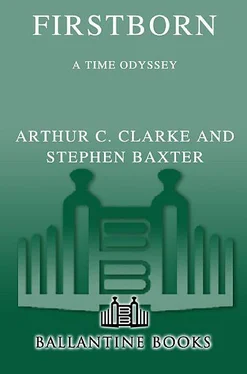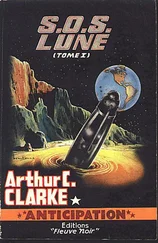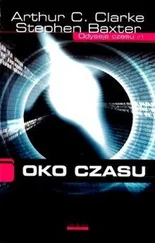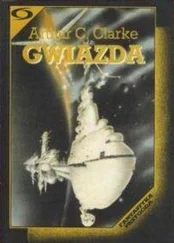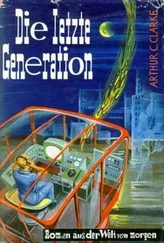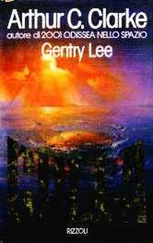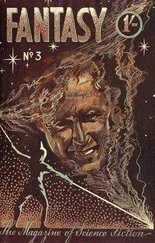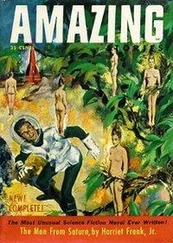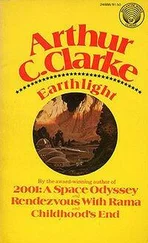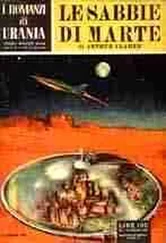The design was simple, in essence. The Liberator looked like nothing so much as a Fourth of July firework, a rocket no less than a hundred meters in length, with habitable compartments stuck on the front end and an immense nozzle gaping at the back. Most of the hull was stuffed with asteroid-mined water ice, dirty snow that would serve as the reaction mass that would drive the ship forward.
And buried somewhere in the guts of the ship, near that nozzle, was the antimatter drive.
Liberator ’s antimatter came in tiny granules of frozen hydrogen—
or rather anti-hydrogen, stuff the propulsion engineers called
“H-bar.” For now it was contained inside a tungsten core, isolated from any normal matter by immaterial electromagnetic walls, the containment itself requiring huge energies to sustain.
H-bar was precious stuff. Because of its propensity to blow itself up on encountering normal matter, antimatter didn’t sit around waiting to be collected, and so had to be manufactured. It occurred as a by-product of the collision of high-energy particles. But Earth’s mightiest accelerators, if run continually, would produce only tiny amounts of antimatter — even the great alephtron on the Moon was useless as a factory. A natural source had at last been found in the
“flux tube” that connected the moon Io to its parent Jupiter, a tube of electrical current five million amperes strong, generated as that moon ploughed through Jupiter’s magnetic field.
To mine antimatter, all you had to do was send a spacecraft into the flux tube and use magnetic traps to sift out antimatter particles.
But there was a world of engineering challenge in that “all.”
When Edna gave the order the magnetic fields would pulse, firing out the H-bar pellets one by one to hammer into an oncoming stream of normal hydrogen. Matter and antimatter would annihilate, every scrap of mass flashing immediately to energy. Asteroid ice would be sublimated to superheated steam, and it was that steam, hurtling out of the nozzle, that would push Liberator forward.
That was really all there was to it, aside from the hugely tricky details of handling the antimatter: Liberator was a steam rocket.
But it was the numbers that were so impressive. Even the great mass-gobbling that went on in the fusing heart of the sun converted only a small percentage of fuel mass to energy. When matter and antimatter annihilated they went all the way; you just couldn’t get more juice out of Einstein’s famous E equals mc squared.
As a result, a mere pinch of antimatter, just fifty milligrams or so, would provide the equivalent of all the energy stored aboard the great chemical-rocket launch systems, like the space shuttle. That was what made the new antimatter drive so useful to governments intent on giving themselves a fast-response capability in the face of an invasion of the solar system. The Liberator was a ship so powerful it would deliver Edna to the Q-bomb, half Jupiter’s distance away, as far as from Earth to the asteroids, in just a hundred and twelve hours.
The Liberator would have been dwarfed by the Spacers’ lightships. But where a lightship was all spiderweb and sail, the Liberator was a solid mass, a club, a weapon. And the design was stupendously phallic, like so many of mankind’s weapon systems in the past, as more than one observer had wryly remarked.
There really wasn’t much for John to do; Libby handled the details of a countdown that was as simple as it could be made to be. John grew steadily more nervous.
“We’re being watched,” Edna said evenly, to distract him.
“We are? Who by?”
“From Achilles. Engineers, administrators, other crew.”
Edna cleared the screen and they glanced down at the ice moon’s surface. The graving dock crawled with spacesuited figures.
“Well, so much for the safety protocols,” John muttered. “What are they doing there?”
Libby replied, “I imagine they have come to watch the launch of mankind’s first spacegoing warship.”
“Wow,” John whispered. “She’s right. Remember Star Wars, Star Trek ?”
Edna had never heard of these ancient cultural relics.
“It all begins here,” John said. “The first warship. But surely not the last, my word.”
“Thirty seconds,” Libby said evenly.
“Thank crap for that,” John said. He clutched the arms of his couch.
This was real, Edna thought suddenly. She was committed; she really was going to ride this ship into battle against an unknown foe, propelled by a drive that had been tested in anger only a couple of times, in a ship so new it still smelled of metal polish.
Libby said, “Three, two, one.”
Somewhere in the guts of the ship a magnetic trap flexed. Matter died.
And Edna was shoved back into her chair with a thrust that drove the breath from her lungs.
The journey wore away.
Even now Alexei wouldn’t allow any communications about sensitive matters, or even “loose talk” in the cabin of the Maxwell, in this tiny volume drifting millions of kilometers from the nearest human. “You never know who’s listening.” And though the space was bigger than aboard the spider, the paper partitions weren’t very soundproof, and Myra and Bisesa felt they had no real privacy.
Nobody talked. They were just as shut-in a crew as they had been on the spider.
After a timeless interval marked only by the gradual dwindling of the sun, Mars loomed out of the dark. Bisesa and Myra peered curiously through the bridge windows.
The approaching world was a sculpture of orange-red, its surface pocked and wrinkled, with a broad smearing of gray mist across much of the northern hemisphere. Compared to Earth, which from space was as bright as a daylight sky, Mars looked oddly dark to Bisesa, murky, sullen.
But as the lightship looped around dwindling orbits she learned to read the landscape. There were the battered southern uplands, punctuated by the mighty bruise of Hellas, and to the north the smoother, obviously younger plains of the Vastitas Borealis. Bisesa was struck how big everything was on Mars. The Valles Marineris canyon system stretched around nearly a quarter the planet’s circumference, and the Tharsis volcanoes were a gross magmatic distortion of the whole planet’s shape.
So much she might have seen had she visited in 1969 rather than 2069. But today Mars’s air was streaked by brilliant white water-vapor clouds. And on one orbit the Maxwell ’s path took them right over the summit of Olympus itself, where black smoke pooled in a caldera wide enough to have swallowed up New York City.
If the scars of the sunstorm were evident on this new face of Mars, so was the handiwork of mankind. The largest settlement on Mars was Port Lowell, an equatorial splash of silver on the fringe of the battered southern uplands. Roads snaked away to all points of the compass, reminiscent of the rectilinear tracery of canals that the last pre-spaceflight observers had imagined they had seen on Mars.
And amid the roads and the domes were splashes of green: life from Earth, flourishing under glass in the soil of Mars.
But Myra pointed out more green, a belt of it stretching across the northern plains, and puddled in the great deep bowl of Hellas, a darker, more somber strain. That had nothing to do with Earth.
Alexei told Bisesa that they would spend a few nights at Lowell. As soon as a surface rover was free she was to travel on, heading north — all the way to the pole of Mars, she learned, with gathering incredulity. She peered down at that dense lid of northern fog, wondering what waited for her beneath its murk.
Читать дальше
